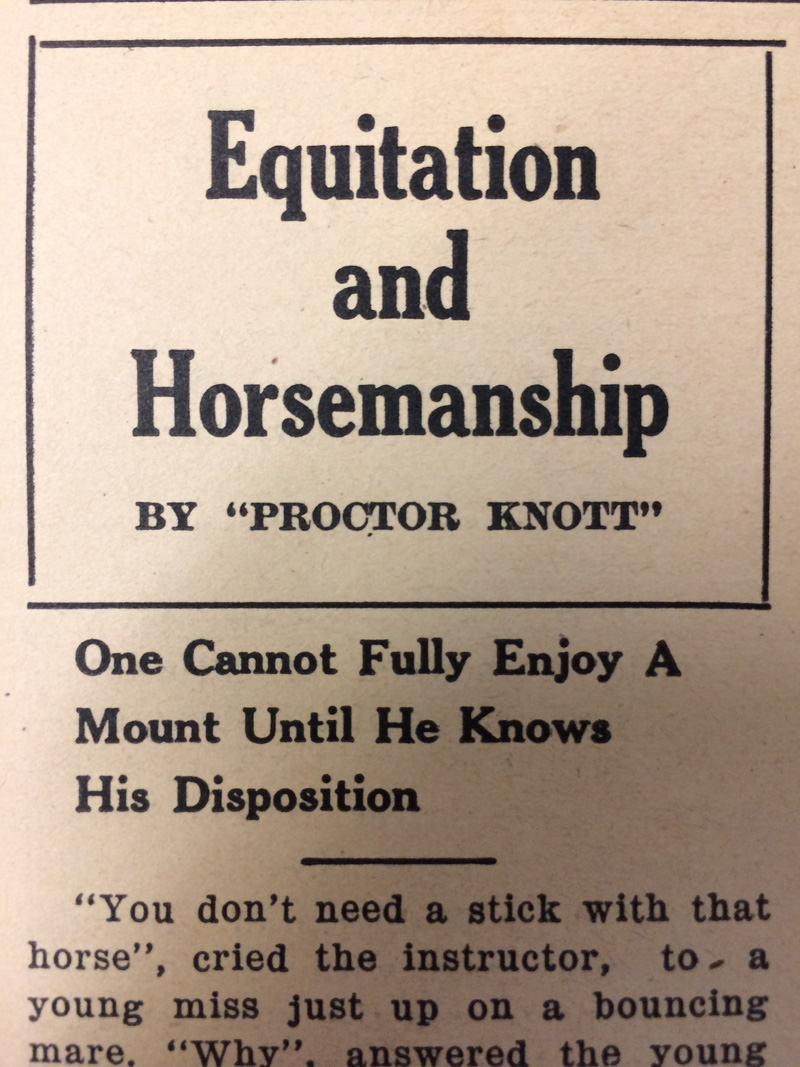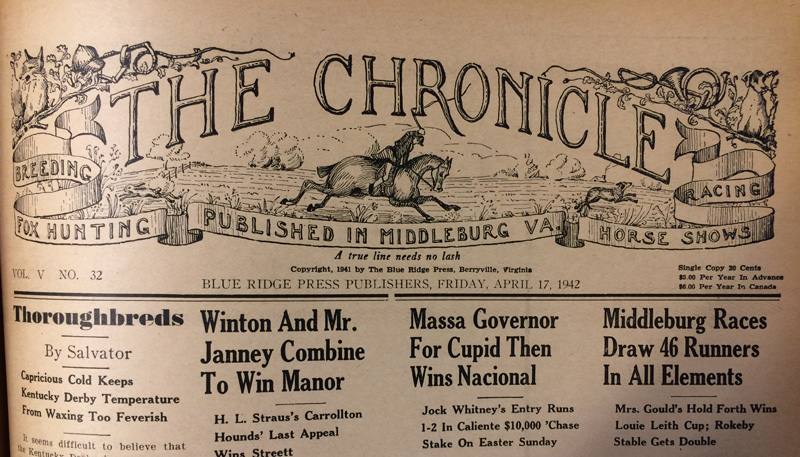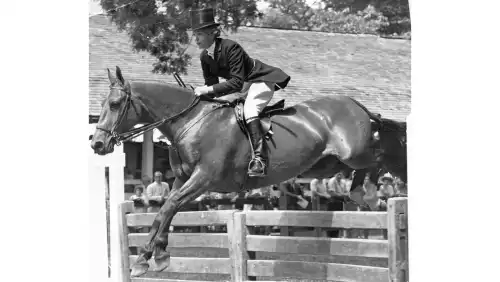In the early days of his career, legendary horseman Bill Steinkraus penned a regular column—Equitation and Horsemanship—for The Chronicle of the Horse under the pseudonym “Proctor Knott.” In the Jan. 29 & Feb. 5 issue of The Chronicle of the Horse, we published an in-depth look at Steinkraus’ life, and for Throwback Thursday we unearthed some of his Chronicle columns from the 1940s.

One Cannot Fully Enjoy A Mount Until He Knows His Disposition
Published in the April 17, 1942 Chronicle
“You don’t need a stick with that horse,” cried the instructor, to a young miss just up on a bouncing mare. “Why,” answered the young lady, “the other day you told me to be sure to always carry a stick!” “Exactly,” he replied, “you were up on the pony then, and he is as lazy as they come. But if you hit this horse, you are liable to have her flying out of the ring with you.”
Sooner or later everyone must learn that methods that work with one horse won’t work with another; some are bold, others are gentle, and their dispositions vary as much as the colors in the rainbow.
It is extremely interesting to study the various characters of horses, and no one can fully enjoy his own mount until he understands his disposition. Sometimes they develop annoying traits which they must be cured of, but more often they develop harmless little quirks that only make them more individual. It is a relief at least that in this machine age horses are not all alike.
Of course there is a lot of nonsense that has been passed down by our ancestors, as well as a lot of sense. Among the nonsense we must put such sweeping statements as “All ponies are stubborn,” “piebalds are unlucky,” “don’t bet on a grey horse,” “a pig-eyed horse,—take care, beware” or the old rhyme:
ADVERTISEMENT
“If you have a horse with for white legs,
Keep him not a day;
If you have a horse with three white legs,
Send him far away;
If you have a horse with two white legs,
Sell him to a friend;
If you have a horse with one white leg,
Keep him to his end.”
Which is all right as a rhyme, but weak reasoning. Irishmen believe a star on the forehead is lucky, but if the star drinks water (i.e. the white blaze goes down into the mouth), that is bad. The fact is that no horse is bad, as such; they are made bad by environment or wrong treatment. Treat a horse well, no matter how he is marked, and you will have a good horse. Treat him badly and he will turn out bad in the end, one white foot notwithstanding.
Brown Jack’s Seat
In “Donoghue Up” that sterling jockey relates many incidents about the horses he rode, and he almost makes them seem real as people. What a character was Brown Jack, of whom he was so fond! One notion of this horse was to squat on his cast iron feed box, strange as it may seem. His indulgent owner then had the cold box upholstered with leather to make it more comfortable, whereupon Brown Jack tore it off and sat on the bare iron again. Finally they had the job done by a professional upholsterer, but still the horse tore it off, so they humored him, and let him sit there.
A horse we once owned used to mutter all the time when he was alone. It was quite a sight. His groom called him the muttering old man, whom he did indeed resemble. Many horses will dunk their hay, methodically taking mouthfuls and dipping it in their water before they will eat it. Others have been known to develop likings for beer, ice cream cones, whiskey, and cigarettes.
And of course the friendships of horses will fill a book! They will pal up with kittens, hens, goats or other pets. One horse was most quiet and contented with a cat sitting on his back. Seabiscuit has a small dog for a constant companion; Exterminator, his famous pony Peanuts, who is never from his side even when put out to pasture. That some pets such as goats are particularly companionable is well-known. In fact it is said goats are the only animal that frightened horses will follow from a burning building. Often a small companion will calm down and make contented the most excited horse.
One day in a bookstore we picked up a book at random among a group on horse training, and happened to open at these words, “The horse is a coward and a fool.” We felt thoroughly disgusted. What a stupid statement! Many incidents through the centuries prove that horses have courage and endurance of the highest order. They are, however, timid of things that are strange to them, a fact we often fail to remember.
What A Horse Shies At
ADVERTISEMENT
Once last summer we jogged a green horse down a country road, and after getting back to the stables we jotted down the things he had been frightened at, and reacted to by shying or some other way. Here is the list: a wrapper from a loaf of bread, a loose poster on a telegraph pole, an old tire (this was last summer!) and a bush. He shied because everything was new and strange to him, but he was not a coward. In two months he was taking 5′ jumps with confidence and courage.
Never hit a horse if he shies at anything; rather let him look at what he fears, and learn that it is nothing to be alarmed at, rather than frighten him the more.
Another thing to remember with a hunter is that the antiquity of horses, jumping is one of their latest skills or acquisitions;—it is not a deeply rooted instinct. So one needs especial patience in teaching a horse to jump. It helps a great deal with young horses and ponies to let them smell their jump, so they are not afraid of them. Some let their horses feel new jumps with the chest. We even know of a blind horse who was taught to jump by this method.
Even so, some like to jump, some don’t, while some like outdoor jumping but dislike indoor jumping. The old-timer gentleman rider Mr. H. V. Page relates amusingly how Iseult and two other top hunters plowed through their fences at the Garden with a crash of falling timber, although they were paragons of virtue in the hunting field.
So in conclusion, here is one part of horsemanship to learn for which there are no rules—to understand your horse, treating him intelligently so that he is well-mannered and unspoiled. As one of the old school has put it, “Without manners of the best, neither man nor horse is fit for polite society.”















